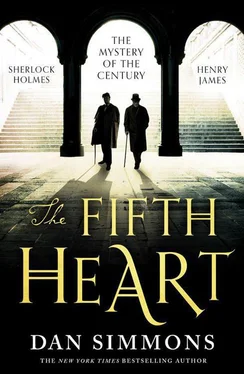“Shall I send for the police?” asked the head housekeeper.
“No,” said the head butler. “William, Charles, get two pokers from the fireplace. Bring one for me. Come with me, William, and we’ll check the back rooms and rear staircase.”
Most of the third floor was given over to servants’ rooms. Holmes had to feel his way in the dark until he found the final staircase—almost steep enough to qualify as a ladder—and as the men stomped and climbed to the second and then third floor below him, calling to one another as they checked rooms, Holmes tip-toed up to the attic. The door to the attic was locked and it took him precious minutes, working in the near absolute darkness, to use his burglar wires and tools to pick that lock. He stepped into the musty attic.
The men had checked all the rooms on the second floor and were converging on the third floor beneath him. Holmes had to risk a light as he shined his lantern in the attic packed with old steamer trunks, a dressmaker’s form rising in front of him like a headless corpse, more suitcases, an empty birdcage. He tip-toed away from the door even as the voices grew louder below him and someone started climbing the steep stairway to the attic. Holmes had been playing his narrow beam across the steeply sloped ceiling until he found the inevitable trap door to the roof.
Luckily it was directly above two tall trunks that he clambered up like a ladder. He put his back into lifting the trap door and hoped that the crashing footfalls below would drown out the slight noise it made as it creaked up on hinges.
Then Holmes was outside on the steep and slippery rooftop.
The trap door had opened onto the back side of the sloping roof that faced the backyards and the stables. Giving silent thanks for H. H. Richardson’s elaborate care with the quality of the building—thick floorboards that had not transmitted his crepe-soled steps, this triple-thick roof with sturdy tiles—Holmes moved quickly toward the taller pitches and chimneys and gables of John Hay’s home.
From H Street and the front of the Adamses’ house, the two grand brick homes looked to be contiguous, but in reality Richardson had separated the east wall of Adams’s house from the west wall of the Hays’ house by a gap of about eighteen inches. Holmes prepared to jump that gap—a narrow black abyss that fell more than fifty feet to the street level—with the full knowledge that the Hays’ roof was slightly higher than the Adamses’ roof he was jumping from.
Hearing noises at the trap door far behind him, Holmes shut down his imagination and leaped. He slid back down the steep, gabled surface, slipping toward the sheer drop-off to blackness, but stopped his descent by spread-eagling his body and using his toes and fingers and his body’s friction against the tiles.
Men were emerging from the trap door in the Adamses’ roof.
Holmes slid two feet to his right. The main chimney handling a dozen outlets to Adams’s many fireplaces on the east side of his huge house was at this east edge of Adams’s rooftop and it was easily twenty feet tall. Holmes kept it between himself and the trap door in order to hide himself from the view of the men emerging onto the Adamses’ roof as he scrambled up the much steeper roofline of the north-south gable on the Hays’ home. He rolled over the ridgeline of that gable and ducked low just as the head butler and his two assistants reached the east end of the Adamses’ roofline and shined their bright lantern along the empty west slopes of the Hays’ gables. Part of the tall, triangular façade that faced H Street and Lafayette Square and the White House hid Holmes from view of anyone out there in the night.
When Adams’s servants had convinced themselves that no burglar was on their rooftop, they carefully—holding hands at one point—made their way back to and down through the trap door into Adams’s attic.
Moving on tip-toe again, only occasionally using his fingertips on the terrible steep rooftop, Holmes went up to the ridgeline and then north along it to where the Hays’ rooftop gabled up to its highest point, the highest ridgeline almost seventy feet above the sidewalk level.
Rather than two massive chimney structures—one west, one east—as on the Adamses’ home, the Hays’ rooftop sprouted six varying brick chimneys.
Holmes allowed himself to slide down the steep upper roof until he’d planted his rubber-crepe soles against a tall, thin chimney only about a third of the way up on the northwest roofline. He rested there a minute, panting softly, and listened to the lonely clop-clop of a single carriage going down Sixteenth Street.
Someone was moving horses into the Adamses’ stables. Holmes had no idea where they’d been stabled during Henry Adams’s weeks of traveling, but here were grooms or stable boys returning them to their stalls at two a.m. Various lanterns and at least one glaring electric light illuminated the stable yards, garden, and the entire west rooftop and west side of the chimney behind which Holmes was hiding. He checked his watch and sighed softly.
This had not been his first or second plan for egress from the presumably empty Adams home and return to his own room. But at least he’d made a Plan C. While the grooms got the horses settled below, trying to keep their work as quiet as possible, Holmes removed the thick loop of rope from his burglar bag.
It would be embarrassing if he’d not estimated the length of the rope properly. Embarrassing and—from this height—most probably fatal.
Eventually the Adamses’ horses were back in their stalls, the lanterns extinguished, and even the glow of light onto the backyard from Adams’s kitchen had grown dark, although Holmes guessed that the butlers, housekeeper, and the few other servants there so late tonight were in their rooms sleeping.
Holmes checked his watch again with the briefest flicker of his hand lantern.
Almost four a.m. The Hays’ domestics would be rising soon to start their interminable days.
Holmes tapped the photo secure over his heart, secured the lantern in his burglar bag, and then made sure the bag was clasped shut and its strap secured over his head and shoulder. There were two coils of rope, one short and one long and heavy. Years ago, he’d learned the basic art of rappelling in the Alps. Now he looped the shorter strand of rope around the fireplace, tied it off securely with double fisherman knots backed up by overhand knots, and ran his longer rope through this anchor sling at mid-point. Running the double rope between his legs, just under his backside, and out to his right hand in what his first Alpine climbing guide had called the dulfersitz .
Firmly holding the doubled line of rope that led to the anchor strap around the chimney in his left hand and the dangling longer strand of doubled rope that made his uncomfortable dulfersitz , he carefully let himself down the steep gable to the west edge of the long drop to the Hays’ backyard.
That morning—the previous morning, he realized now—and again that afternoon, he’d walked to the rear and sides of the Hays’ backyard, nominally to smoke his pipe and think but actually to look up and measure the alignment of this thinnest of the six chimneys directly above his second-floor (by American reckoning) room. Now he had to trust to his estimated measurement even while trusting again that no servant, wandering the halls after midnight, had felt a draft in the hallway and been brazen enough to go into his guest room and shut and latch the window he’d left open. Someday, some repairman on the roof would find his anchor sling, but that was of no concern to Holmes this night. Leaning far back, almost to the horizontal, letting the rappel rope shuffle through his left hand as he wrapped the other length of rope around his right wrist, Holmes walked himself down the side of John Hay’s huge brick home, hopping the four feet over the dark window on the third floor that Holmes had ascertained earlier to be an empty servant’s bedroom currently being used for storage.
Читать дальше












